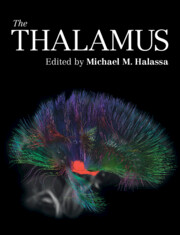Book contents
- The Thalamus
- The Thalamus
- Copyright page
- Contents
- Contributors
- Preface
- Section 1: History
- Section 2: Anatomy
- Section 3: Evolution
- Section 4: Development
- Chapter 7 Development of the Thalamocortical Systems
- Chapter 8 Ontogeny of Thalamic GABAergic Neurons
- Section 5: Sensory Processing
- Section 6: Motor Control
- Section 7: Cognition
- Section 8: Arousal
- Section 9: Computation
- Index
- References
Chapter 8 - Ontogeny of Thalamic GABAergic Neurons
from Section 4: - Development
Published online by Cambridge University Press: 12 August 2022
- The Thalamus
- The Thalamus
- Copyright page
- Contents
- Contributors
- Preface
- Section 1: History
- Section 2: Anatomy
- Section 3: Evolution
- Section 4: Development
- Chapter 7 Development of the Thalamocortical Systems
- Chapter 8 Ontogeny of Thalamic GABAergic Neurons
- Section 5: Sensory Processing
- Section 6: Motor Control
- Section 7: Cognition
- Section 8: Arousal
- Section 9: Computation
- Index
- References
Summary
GABAergic interneurons are present in the thalamus of amniotes to provide local inhibition and potentially contribute to the pacing of thalamocortical network activity. However, it has long been known that the density of GABAergic interneurons varies greatly between thalamocortical subdivisions among animal species. In mammals, the GABAergic interneurons that are invariantly found in the visual areas of the thalamus are very rare in other sensory and associative regions in rodents but not in carnivores and primates. Are GABAergic interneurons dispensable for the faithful relay of sensory information? Are there different interneuron types allocated to thalamocortical hierarchies and sensory modalities? Are thalamic interneurons the product of evolutionarily conserved differentiation programmes, or do they represent examples of convergence and novelty in evolution? Important clues for answering these open questions may come from an understanding of the genesis of thalamic GABAergic neurons in different species. Neuronal cell fate in the embryonic thalamic primordium is overwhelmingly of the glutamatergic type. Recent research identified multiple extra-thalamic sources of thalamic interneurons, suggesting that the correct cellular assembly of the thalamus also depends on the species-specific maturation of other regions of the brain.
Keywords
- Type
- Chapter
- Information
- The Thalamus , pp. 163 - 186Publisher: Cambridge University PressPrint publication year: 2022

